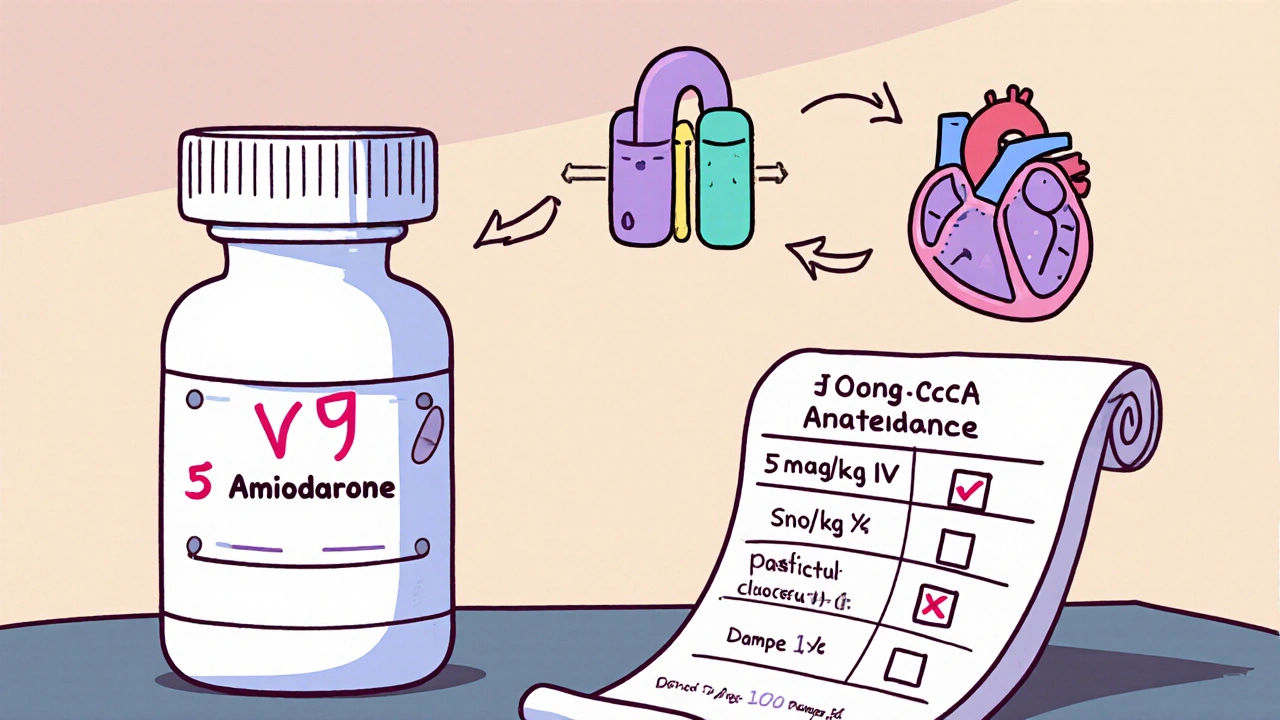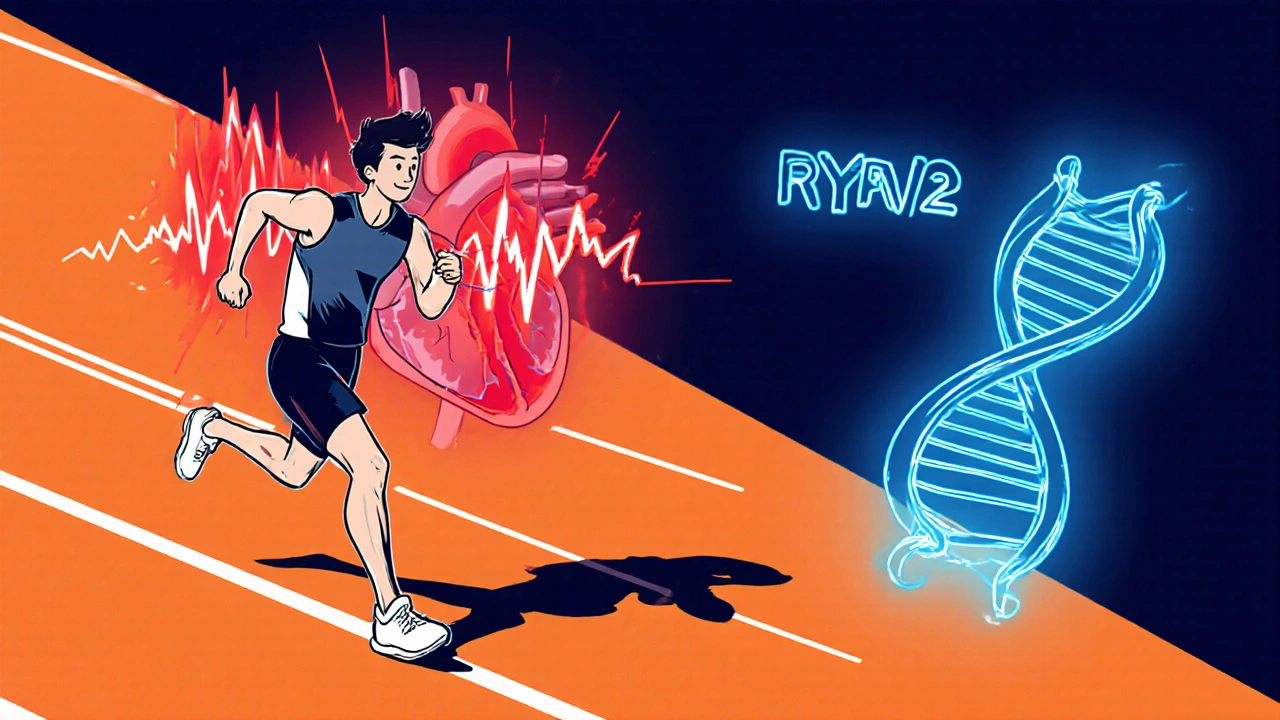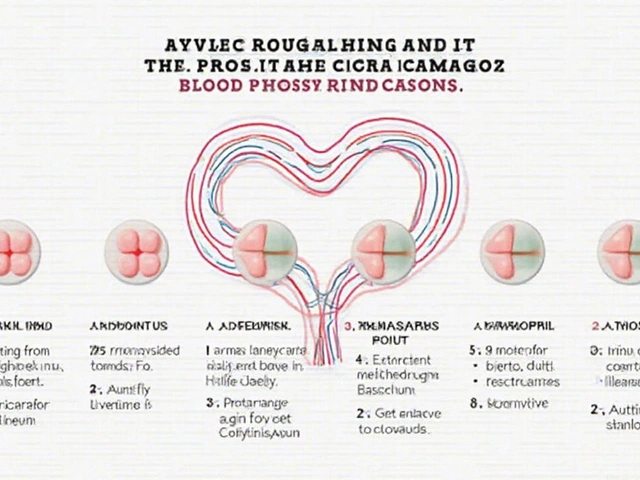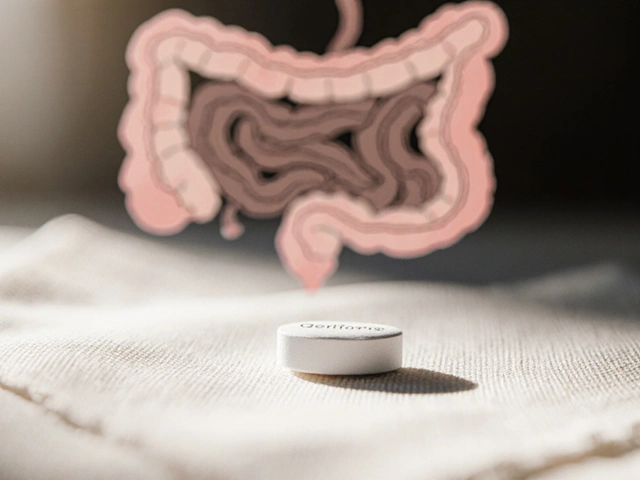Amiodarone Dosing Calculator for CPVT
How to Use This Calculator
Enter the patient's weight in kilograms to calculate appropriate amiodarone dosing for CPVT. Note: This is for informational purposes only. Always consult current clinical guidelines and a healthcare provider.
Check TSH, liver enzymes, and chest imaging after 1 month. Repeat every 3 months for first year.
Important Notes
Warning Amiodarone has significant long-term toxicity risks including thyroid, lung, and liver complications. This is a second-line option only when beta-blockers and flecainide fail or are contraindicated.
Quick Takeaways
- CPVT is a rare, inherited arrhythmia triggered by stress or exercise.
- Beta‑blockers remain first‑line, but some patients need additional drugs.
- Amiodarone can suppress ventricular episodes, but its long‑term toxicity limits routine use.
- Flecainide and implantable cardioverter‑defibrillators (ICDs) are common alternatives.
- Close monitoring of thyroid, liver, and lung function is essential when amiodarone is prescribed.
Understanding Catecholaminergic Polymorphic Ventricular Tachycardia (CPVT)
When you hear the term CPVT, think of a heart that suddenly goes into a chaotic rhythm during adrenaline spikes - like a sprint or a scary movie. The condition is caused by genetic mutations, most frequently in the RYR2 gene, which encodes the cardiac ryanodine receptor responsible for calcium release during each beat.
Because the faulty calcium channel leaks during stress, the ventricles fire off rapid, life‑threatening beats called ventricular tachycardia (VT). Unlike structural heart disease, CPVT patients usually have a normal echocardiogram, making diagnosis rely heavily on exercise‑stress testing and genetic panels.
What Is Amiodarone and How Does It Work?
Amiodarone is a class III antiarrhythmic that blocks potassium channels, prolonging the cardiac action potential. It also touches sodium channels, beta‑adrenergic receptors, and calcium channels, giving it a “broad‑spectrum” profile.
In CPVT, the drug’s ability to dampen calcium‑triggered afterdepolarizations makes it an attractive back‑up when beta‑blockers alone can’t control episodes. However, its lipophilic nature means it sticks around in body tissues for weeks, leading to potential thyroid, pulmonary, hepatic, and ocular side effects.
When Do Clinicians Consider Amiodarone for CPVT?
Guidelines from the Heart Rhythm Society list amiodarone as a “second‑line” option. Typical scenarios include:
- Failure of maximal beta‑blocker therapy (e.g., propranolol at 4 mg/kg/day).
- Intolerance or contraindication to other antiarrhythmics like flecainide.
- Patients awaiting ICD implantation who need interim rhythm control.
- Refractory ventricular bursts during an acute hospital admission.

Dosage and Monitoring Guidelines
Because amiodarone’s therapeutic window is narrow, start low and go slow.
| Phase | Loading Dose | Maintenance Dose | Duration |
|---|---|---|---|
| Initial | 5 mg/kg IV over 24 h (max 400 mg) | - | 24 h |
| Transition | 200 mg PO daily for 1 week | - | 1 week |
| Maintenance | - | 100-200 mg PO daily | Ongoing |
After the first month, check thyroid‑stimulating hormone (TSH), liver enzymes (ALT/AST), and chest X‑ray or high‑resolution CT for early lung changes. Repeat labs every 3 months for the first year, then semi‑annually.
Comparing Amiodarone to Other CPVT Therapies
| Drug / Device | Mechanism | Typical Dose | Pros | Cons |
|---|---|---|---|---|
| Beta‑blocker | Blocks β‑adrenergic stimulation | Propranolol 1‑4 mg/kg/day | Well‑studied, low cost | May be insufficient alone |
| Flecainide | Na⁺ channel blocker, reduces afterdepolarizations | 200‑300 mg PO BID | Effective when β‑blockers fail | Pro‑arrhythmic in structural heart disease |
| Implantable cardioverter‑defibrillator (ICD) | Detects & terminates VT/VF electrically | Device‑specific programming | Life‑saving for high‑risk patients | Invasive, risk of inappropriate shocks |
| Amiodarone | Class III K⁺ channel blocker + multi‑channel effects | 100‑200 mg PO daily (after loading) | Broad anti‑arrhythmic coverage | Long‑term organ toxicity, drug interactions |
In practice, most physicians start with beta‑blockers, add flecainide if needed, and reserve amiodarone for those who cannot tolerate flecainide or need a bridge to ICD therapy.
Side‑Effect Profile and Risk Management
Amiodarone’s toxicity is the main reason it’s not first‑line. Key organ systems to watch:
- Thyroid: Both hypo‑ and hyper‑thyroidism occur in 15‑20 % of patients.
- Lung: Pulmonary fibrosis can develop after 6-12 months; look for dry cough or dyspnea.
- Liver: Transaminase elevations are common; severe hepatitis is rare.
- Eye: Corneal micro‑deposits (visible under slit‑lamp) are usually benign.
- Drug interactions: Inhibits CYP3A4, affecting warfarin, statins, and digoxin.
Because the drug’s half‑life is 58‑100 days, any adverse effect may linger even after discontinuation. That’s why a shared decision‑making conversation is vital before starting therapy.
Practical Steps for Clinicians and Patients
- Confirm CPVT diagnosis with exercise stress test and genetic testing.
- Initiate a beta‑blocker at the appropriate weight‑based dose.
- Assess response after 4‑6 weeks; if VT persists, consider adding flecainide.
- If flecainide is contraindicated or ineffective, discuss amiodarone’s risk‑benefit profile.
- Start amiodarone loading as outlined, then transition to maintenance.
- Set up a monitoring schedule: baseline labs, ECG, chest imaging, and ophthalmology exam.
- Re‑evaluate every 3 months; if side effects emerge, taper off and switch to alternative therapy.
Patients should keep a symptom diary, noting activities that trigger palpitations. Sharing this log helps the care team fine‑tune doses and decide whether an ICD is warranted.
Future Directions and Ongoing Research
Recent trials (2023‑2024) are exploring selective RyR2 stabilizers that target the root cause of CPVT without the systemic toxicity of amiodarone. Early phase II data suggest fewer arrhythmic events with a better safety profile, but these agents are still months away from market approval.
Until then, amiodarone remains a useful, albeit heavy‑handed, tool in the armamentarium for refractory CPVT.
Frequently Asked Questions
Can amiodarone cure CPVT?
No. Amiodarone controls the abnormal rhythms but does not fix the underlying genetic defect. Long‑term management still requires lifestyle adjustments and possibly an ICD.
How long does it take for amiodarone to start working?
Therapeutic effects can be seen within a few days of the loading dose, but full steady‑state levels usually require 4‑6 weeks of maintenance dosing.
Is it safe to combine amiodarone with beta‑blockers?
Yes, they are often used together. However, clinicians should monitor heart rate and blood pressure closely to avoid excessive bradycardia.
What are the warning signs of amiodarone‑induced lung toxicity?
Persistent dry cough, shortness of breath, or new infiltrates on chest X‑ray should prompt immediate evaluation and possible drug discontinuation.
Should children with CPVT ever receive amiodarone?
Pediatric use is rare and reserved for life‑threatening situations. The long‑term side‑effect burden is especially concerning in growing patients.







erica fenty
October 21, 2025 AT 16:56 PMAmiodarone loading is typically 5 mg/kg IV over 24 h; the max is 400 mg, then transition to 200 mg PO daily for a week before settling on 100‑200 mg maintenance. Monitoring should include TSH, LFTs, and a baseline chest X‑ray, then repeat every three months. The pharmacokinetics are long‑acting, so steady‑state isn’t reached until 4‑6 weeks.
Xavier Lusky
October 30, 2025 AT 23:10 PMNever forget that the pharma giants push amiodarone because it locks you into lifelong monitoring, which means more clinic visits and more profit for the system. The “guidelines” are just a way to keep the market saturated with expensive drugs while alternative therapies get sidelined. Keep your eyes open.
Ashok Kumar
November 9, 2025 AT 05:23 AMSure, amiodarone works, but using it as a last‑ditch effort feels like putting a band‑aid on a broken dam – it might stop the leak for a bit, but the underlying issue remains. Sarcastically, we’re just swapping one set of side‑effects for another, hoping the patient doesn’t notice until it’s too late. Still, if beta‑blockers and flecainide fail, you’ve got to do something.
Jasmina Redzepovic
November 18, 2025 AT 11:36 AMFrom a clinical standpoint, the US guidelines are crystal clear: beta‑blockers first, flecainide second, amiodarone only when you’ve exhausted all other options. The evidence base is robust; the drug’s multi‑channel blockade is well documented, and the toxicity profile is non‑negotiable. Anyone suggesting otherwise is either uninformed or pushing a national agenda that downplays American cardiology standards.
Esther Olabisi
November 27, 2025 AT 17:50 PMExactly! 👍 Teamwork makes the dream work, and sharing monitoring tips can save lives. Let’s keep the conversation friendly and helpful 😊.
Ivan Laney
December 7, 2025 AT 00:03 AMWhile I appreciate the enthusiasm, let’s not forget that the United States has set the gold standard for cardiac care, and any deviation from the established protocol undermines patient safety. The data supporting amiodarone’s role as a bridge therapy is unequivocal, and our duty is to apply it judiciously, not to dilute it with frivolous optimism. Moreover, when clinicians mention “teamwork,” they must also emphasize rigorous adherence to monitoring schedules, because a missed thyroid panel can have catastrophic consequences. It is not enough to say “let’s keep it friendly”; we must enforce protocol compliance across all institutions. In other words, patriotism in medicine means demanding the highest standards, not settling for half‑measures. The alternative-an unchecked proliferation of anecdotal practices-would be a disservice to the very patients we claim to protect. Therefore, I urge my colleagues to double‑check dosage calculations, ensure proper patient education, and hold each other accountable. Only then can we truly claim to uphold the prestige of American cardiology.